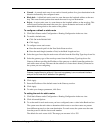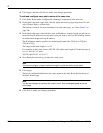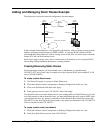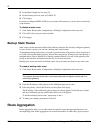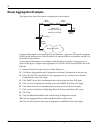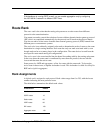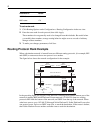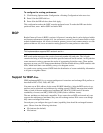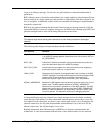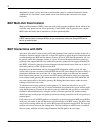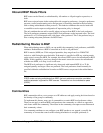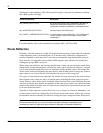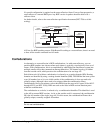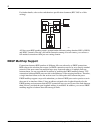
Nokia Network Voyager for IPSO 4.0 Reference Guide 403
To configure the routing preferences
1. Click Routing Options under Configuration > Routing Configuration in the tree view.
2. Enter 10 in the OSPF edit box.
3. Enter 40 in the RIP edit box; then click Apply.
This configuration makes the OSPF route the preferred route. To make the RIP route be the
preferred route, enter
40 for OSPF and 10 for RIP.
BGP
Border Gateway Protocol (BGP) is an inter-AS protocol, meaning that it can be deployed within
and between autonomous systems (AS). An autonomous system is a set of routers under a single
technical administration. An AS uses an interior gateway protocol and common metrics to route
packets within an AS; it uses an exterior routing protocol to route packets to other ASes.
Note
This implementation supports BGP version 4 and 4++.
BGP sends update messages that consist of network number-AS path pairs. The AS path
contains the string of ASes through which the specified network can be reached. An AS path has
some structure in order to represent the results of aggregating dissimilar routes. These update
messages are sent over TCP transport mechanism to ensure reliable delivery. BGP contrasts with
IGPs, which build their own reliability on top of a datagram service.
As a path-vector routing protocol, BGP limits the distribution of router reachability information
to its peer or neighbor routers.
Support for BGP-4++
IPSO implements BGP-4++ to support multiprotocol extensions and exchange IPv6 prefixes as
described in RFCs 2545, 2858, and 3392.
You must use an IPv4 address for the router ID (BGP identifier). After the BGP session is up,
prefixes can be advertised and withdrawn by sending normal UPDATE messages that include
either or both of the new multiprotocol attributes MP_REACH_NLRI (used to advertise
reachability of routes) and MP_UNREACH_NLRI (used to withdraw routes).
The new attributes are backward compatible. If two routers have a BGP session and only one
supports the multiprotocol attributes, they can still exchange unicast IPv4 routes even though
they cannot exchange IPv6 routes.
On each peer you configure the type of routes (capability) that should be exchanged between
peers. Choose from the following selections:
IPv4 unicast (the default)
IPv6 unicast



